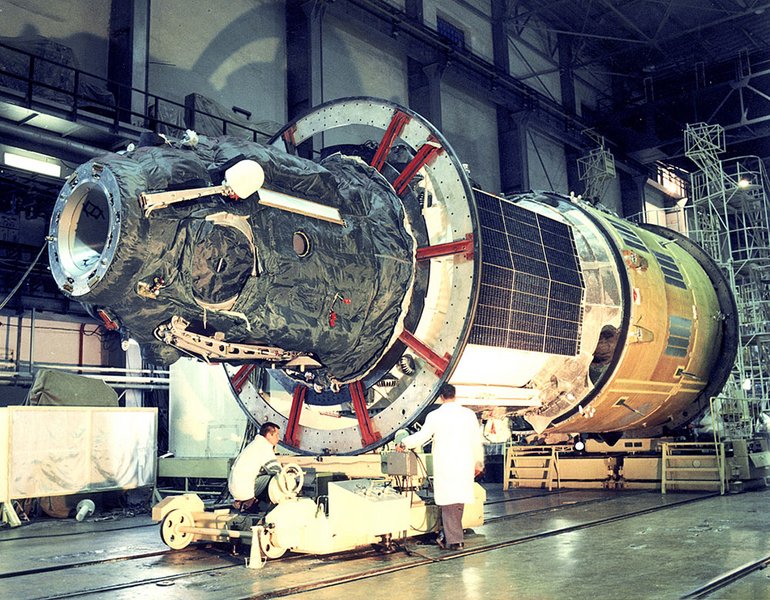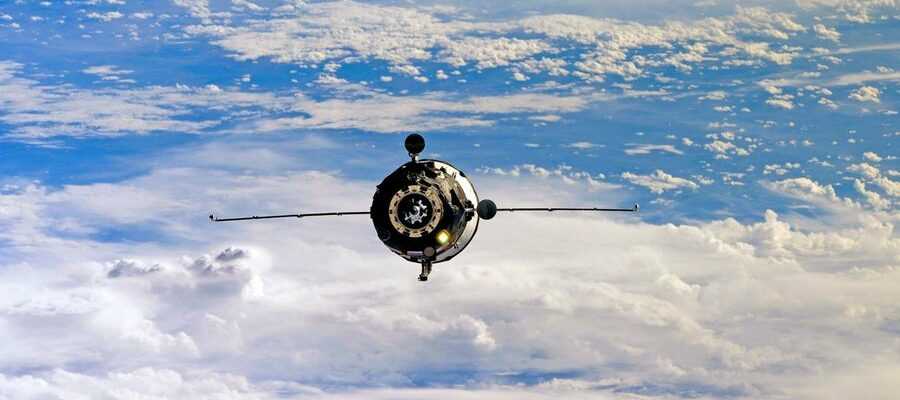A few days apart, a cargo
Russian Progress and an American freighter Cygnus arrived on the international space station
. The seven crew members have received enough to live on and continue their hundreds of experiments… The context on Earth may be more and more tense, but their mission depends on collaboration.
Maybe it’s time for a group photo or a big dinner.
Prepare the hatches!
It was the week dedicated to the arrival of new freighters. On February 17, two days after takeoff, the Russian Progress MS-19 vehicle got the ball rolling by docking fully automatically with the Poisk module. It was carrying almost 2.5 tons of cargo, including 430 kg of maneuvering fuel, 420 liters of drinking water and 40 kg of pressurized nitrogen for the on-board systems.
The remaining 1.6 tonnes of cargo were in Progress’s pressurized bay: food, clothing, equipment to keep the Nauka laboratory running, a new repair kit to deal with the cracks in the rear of the Zvezda module, six small satellites that will be ejected “by hand” during a future spacewalk and equipment for various experiments. The two cosmonauts busy with this unpacking, the non-Russian segment (USOS) in turn prepared for the arrival of a cargo ship, the Cygnus NG-17, which took off last Saturday.
Fresh in freight
Moored yesterday (February 21) using the large robotic arm Canadarm2, Cygnus in turn brought 3.5 tons of equipment and food, including fresh fruit and vegetables (avocados, tomatoes, grapes, pears, etc.).
On the hardware side, this time there is enough to install the solar panels that will arrive in SpaceX’s next Dragon cargo ship, extra tanks for oxygen and nitrogen as on the Russian side, new lighting for the robotic arm, parts of diving suits and a multitude of scientific experiments. Some are funded by private actors, such as a study by Colgate-Palmolive on skin aging in orbit.
This Cygnus cargo ship, which will remain on the station for about a month and a half, will also have the task of correcting the altitude of the ISS (generally, it is rather the Russian side that takes care of this), and it carries CubeSats , some of which will be dropped directly from the cargo ship before it leaves to disintegrate in the Earth’s atmosphere in April.
Keeping busy so as not to evoke the crisis?
For the seven occupants of the Station (two Russians, one German, four Americans), these two vehicles and their contents will allow them to continue their activities, in what promises to be a studious month: several weeks of experiments, the preparation for extravehicular outings on the American side (installation of panels) and on the Russian side (activation of the European robotic arm ERA). Four busy weeks before the ISS crew rotations in early spring.
Departures and arrivals will start on March 18 with the liftoff of Soyuz MS-21. In any case, that is what is expected. It will have escaped no one that the tensions between Russia and the West (in dispersed order between European powers and the United States) have been at their peak since 2014, with the fragmentation and then the annexation of part of the ‘Ukraine. Astronauts, who are generally the first defenders and ardent advocates for international cooperation, must experience a special atmosphere. However, barring all-out conflict (and evacuation), work and even life on the ISS depends on collaboration between all players. It’s been going on for 21 years… and since 2014, it hasn’t posed (too many) problems.
Between cohabitation and friction
Indeed, in an extreme case, there is no question of doing more than closing the hatches which separate the Russian and USOS sections of the Station… and the occupants could refuse to do so, in particular for security reasons. There is no “red button” to suddenly eject neighboring modules, which are interconnected in particular from the outside, and even so, it would be useless. For material questions first, since the central computer and the piloting of the ISS are installed in the Russian module Zvezda, while the American solar panels provide the electricity necessary for the two segments.
On the human side too, we can add that the American astronaut Mark Vande Hei came to the ISS in Soyuz with his Russian colleagues (and that he will not leave until April). Other collaborations and exchanges of the kind are already planned with Anna Kikina on Crew Dragon next fall, while the Russian, American and Ukrainian space sectors have succeeded despite the 2014 crisis in collaborating so far. The Cygnus NG-17 is a magnificent example. Its Antares launcher uses Russian engines, a Ukrainian first stage, American components, and the cargo itself has an Italian pressurized compartment.
It remains to be seen whether the current crisis will have repercussions on this type of program, or even on the ISS itself.

It took four rocky years and several bitter failures, but this time… Does it work? In December 1974, the USSR sent its sixth space station into orbit, and despite some setbacks, Salyut -4 was the first to be visited by several crews. A decisive success that prepares the sequel.
Read more
Source: Nasaspaceflight

9